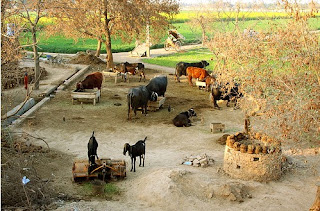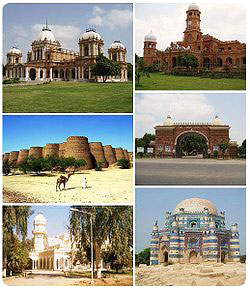Punjab is The Largest Province by Population in Pakistan
Punjab
is Pakistan's most populous province with an estimated population of
101,391,000 as of 2015 and Punjab has an area of 205,344 sq km and it is the
2nd largest province after Balochistan and is located at the northwestern edge
of the geologic Indian plate in South Asia. The province is bordered by Azad
Kashmir to the north-east, the Indian states of Punjab and Rajasthan to the
east, the province of Sindh to the south, the province of Balochistan to the
southwest, the province of Khyber Pakhtunkhwa to the west, and the Islamabad
Capital Territory to the north. The
capital and largest city is Lahore which was the historical capital of India
during the Moghul times. Other important cities of Punjab include Gujrat,
Multan, Faisalabad, Sheikhupura, Sialkot, Gujranwala, Jhelum and Rawalpindi. Punjab
is a mainly a fertile region along the river valleys. While in the southern
belt deserts of Cholistan is a bare land. The landscape is amongst the most
heavily irrigated on earth and canals can be found throughout the province.
Weather extremes are notable from the hot and barren south to the cool hills of
the north. The foothills of the Himalayas are found in the extreme north as
well.
The
Lahore, capital of Punjab is a cultural centre of Pakistan where the country's
cinema industry, and much of its fashion industry, is based. Punjab literally
means the land of 5 rivers term refers to the 5 rivers flowing thru the region.
Due to its rivers of Punjab is the most fertile and most populated province of
Pakistan. People speak Punjabi here and have many colorful traditions and culture of Punjab is very rich. Punjab
is considered most developed, populous, and prosperous province of Pakistan
having about 60% of the country's total population being placed in it.
In
1947, the Punjab province of British India was divided along religious lines
into West Punjab and East Punjab. Western Punjab was equated into the new
country of Pakistan, while East Punjab became a part of modern-day India. This
resulted in massive rioting as both sides committed atrocities against fleeing
refugees. The part of the Punjab now in Pakistan once formed a major region of
British Punjab, and was host to a large minority population of Punjabi Sikhs
and Hindus up to 1947 apart from the Muslim majority. Migration between India
and Pakistan was continuously before independence. By the 1900s Western Punjab
was predominantly Muslim and supported the Muslim League and the Pakistan
Movement. After independence, the minority Hindus and Sikhs migrated to India
while Muslim refugees from India settled in the Western Punjab and across
Pakistan. Since the 1950s, Punjab industrialised rapidly. Modern factories were
established in Lahore, Sargodha, Multan, Gujrat, Gujranwala, Sialkot and Wah.
In the 1960s, the new city of Islamabad north of Rawalpindi.
Agriculture
remains the largest sector of Punjab's economy. The province is the breadbasket
of the country as well as home to the largest ethnic group in Pakistan, the
Punjabis. Unlike neighbouring India, there was not any large-scale
redistribution of agricultural land. As a result, most rural areas are
characterized by a small set of feudalistic land-owning families. In
the 1950s, there was tension between the eastern and western halves of
Pakistan. To address the situation, a different formula resulted in the
abolition of the province status for Punjab in 1955. It was merged into a
single province of West Pakistan. In 1972, after East Pakistan seceded and
became Bangladesh, Punjab again became a province. Punjab witnessed major
battles between the armies of India and Pakistan in the wars of 1965 and 1971.
Since the 1990s, Punjab hosted several key sites of Pakistan's nuclear program
such as Kahuta. It also hosts major military bases such as at Sargodha and
Rawalpindi. The peace process between India and Pakistan, which began in
earnest in 2004, has helped pacify the situation. Trade and people-to-people
contacts through the Wagah border are currently starting to become common.
Indian Sikh pilgrims visit holy sites such as Nankana Sahib. Starting in the 1980s,
large numbers of Punjabis migrated to the Middle East. Britain, Spain, Canada
and the United States for economic opportunities, forming the large Punjabi
diaspora. Business and cultural ties between the United States and Punjab are
growing.
Punjab
is Pakistan's most industrialised province with the industrial sector making up
24% of the province's gross domestic product and its manufacturing industries
produce textiles, sports goods, heavy machinery, electrical appliances,
surgical instruments, vehicles, auto parts, metals, sugar mill plants,
aircraft, cement, agricultural machinery, bicycles and rickshaws, floor
coverings, and processed foods. In 2003, the province manufactured 90% of the
paper and paper boards, 71% of the fertilizers, 69% of the sugar and 40% of the
cement of Pakistan.
Punjab
gets the largest economy in Pakistan, contributing most to the national GDP.
The province's economy has quadrupled since 1972. its share of Pakistan's GDP
was 54.7% in 2000 and 59% as of 2010. It is particularly dominant in the
service and agriculture sectors of Pakistan's economy. With its contribution
ranging from 52.1% to 64.5% in the Service Sector and 56.1% to 61.5% in the
agriculture sector. It is also a major manpower contributor because it has the
largest pool of professionals and highly skilled manpower in Pakistan. It is
also dominant in the manufacturing sector, though the dominance is not as huge,
with historical contributions ranging from a low of 44% to a high of 52.6%. In
2007, Punjab achieved a growth rate of 7.8% and during the period 2002-03 to
2007-08, its economy grew at a rate of between 7% to 8% per year. and during
2008-09 grew at 6% against the total GDP growth of Pakistan at 4%. Punjab
is known in Pakistan for its relative prosperity, and has the lowest rate
of poverty amongst all Pakistani provinces. A clear divide is found between the
northern and southern portions of the province with poverty rates in prosperous
northern Punjab amongst the lowest in Pakistan, while some in south Punjab are
among the most impoverished. Punjab is among South Asia's most urbanized
regions with approximately 40% of people living in urban areas. Its human
development index rankings are high relative to the rest of Pakistan. Punjab
is well known in Pakistan for its relatively liberal social attitudes. The
province has been greatly influenced by Sufism, with numerous Sufi shrines
spread across Punjab which attract millions of devotees annually. The founder
of the Sikh faith, Guru Nanak, was born in the Punjab town of Nankana Sahib
near Lahore. Punjab is equally the site of the Katasraj Temple, which features
prominently in Hindu mythology. Several UNESCO World Heritage Sites are located
in Punjab, including the Shalimar Gardens, Lahore Fort, the archeological
excavations at Taxila, and the Rohtas Fort.

Punjab's
landscape consists most of fertile alluvial plains of the Indus
River and its four major tributaries in Pakistan, the Jhelum, Chenab, Ravi, and
Sutlej rivers which traverse Punjab north to south - the fifth of the five waters of Punjab, the Beas River, lies exclusively in the
Indian state of Punjab. The landscape is amongst the most heavily irrigated on
earth and canals can be found throughout the province. Punjab also includes
several mountainous regions, including the Sulaiman Mountains in the southwest part
of the province, the Margalla Hills in the north near Islamabad, and the Salt
Range which divides the most northerly portion of Punjab, the Pothohar Plateau,
from the rest of the province. Sparse deserts can be found in southern Punjab
near the border with Rajasthan and near the Sulaiman Range. Punjab also
contains part of the Thal and Cholistan deserts. In the north, Punjab's
elevation reaches 2,291 metres near the hill station of Murree, which is
surrounded by lush and dense forest. Most
areas in Punjab experience extreme weather in foggy winters, often accompanied
by rain. By mid-February the temperature starts to rise; springtime weather
continues until mid-April, when the summer heat sets in.
The
onset of the southwest monsoon is anticipated to reach Punjab by May. But since
the early 1970s the weather pattern has been irregular. The spring monsoon has
either skipped over the area or has caused it to rain so hard that floods have
resulted. June and July are oppressively hot. Although official estimates
rarely place the temperature above 46 °C, newspaper sources claim that it
reaches 51 °C and regularly carry reports about people who have succumbed to
the heat. Heat records were broken in Multan in June 1993, when the mercury was
reported to have risen to 54 °C. In August the oppressive heat is punctuated by
the rainy season, referred to as barsat, which brings relief to its wake. The
hardest part of the summer is then over, but cooler weather does not come until
late October. Recently the province experienced one of the coldest winters in
the last 70 years. Punjab's regional temperature ranges from −2° to 45 °C, but
can reach 50 °C,122 °F, in summer and can touch down to −10 °C in Winter.
Climatically. Punjab has three major seasons. Hot weather, April to June, when
the temperature rises as high as 110 °F. Rainy seasons, July to September.
Average rainfall annual ranges between 96cm sub-mountain regions and 46cm in
the Plains. Cooler, Foggy and mild weather, October to March. temperature goes
down as low as 40 °F. weather extremes are notable from the hot and barren
south to the cool hills of the north. The foothills of the Himalayas are found
in the extreme north as well, and features a much cooler and wetter climate,
with snowfall common at higher altitudes.

The
major and native language spoken in the Punjab is Punjabi, which is written in
a Shahmukhi script in Pakistan and Punjabis comprise the largest ethnic group
in country. Punjabi is the provincial language of Punjab. There is not a single
district in the province where the Punjabi language is mother-tongue of less
than 89% of the population. The language does not receive any official
recognition in the Constitution of Pakistan at the national level. Punjabi
dialects spoken in the province include Majhi, Standard, Saraiki and Hindko.
Punjabi Saraiki is mostly spoken in southern Punjab, and Pashto, spoken in some
parts of north west Punjab, especially in Attock district and Mianwali district
near Khyber Pakhtunkhwa province.
The
Government of Punjab is a provincial government in the federal structure of
Pakistan, is based in Lahore, the capital of the Punjab province. The Chief
Minister of Punjab is elected by the Provincial Assembly of the Punjab to serve
as the head of the provincial government of Punjab, Pakistan. The current Chief
Minister is Shahbaz Sharif, who became the Chief Minister of Punjab is being
restored after Governor's rule starting from 25 February 2009 to 30 March 2009.
Thereafter got re-elected as a result of 11 May 2013 elections. The Provincial
Assembly of the Punjab is a unicameral legislature of elected representatives
of the province of Punjab, which is located in Lahore in eastern Pakistan. The
Assembly was established pursuant to Article 106 of the Constitution of
Pakistan as having a total of 371 seats, with 66 seats reserved for women and
eight reserved for non-Muslims. There are 48 departments in the Punjab
government. Each department is headed by a Provincial Minister, politician and
a Provincial Secretary, a civil servant of usually BPS-20 or BPS-21. All
Ministers report to the Chief Minister, who is the Chief Executive. All
Secretaries report to the Chief Secretary of Punjab, who is usually a BPS-22
Civil Servant. Chief Secretary in turn reports to the Chief Minister. In
addition to these departments, there are several Autonomous Bodies and Attached
departments that report directly to either the secretaries or the Chief
Secretary.








































